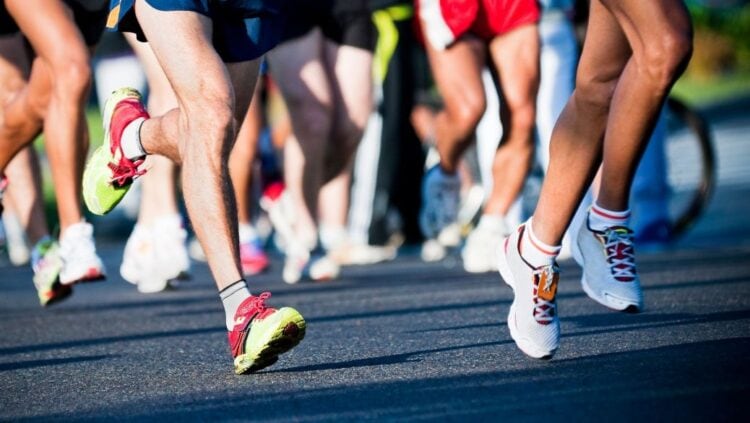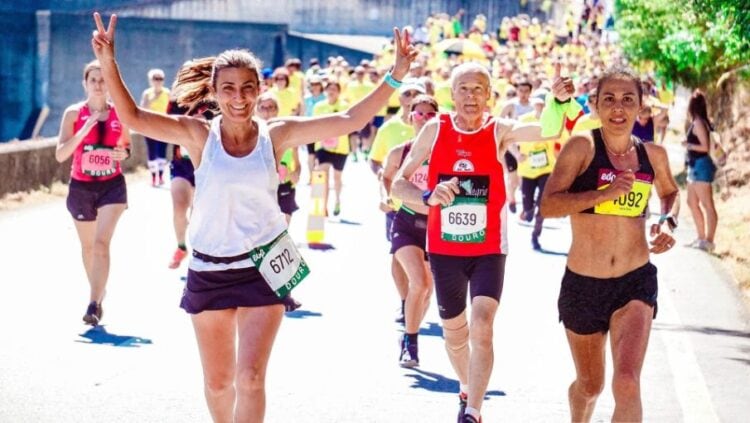
OBJECTIVE OF MARATHON: Complete the 26.2-mile race in the least amount of time possible.
NUMBER OF PLAYERS: 2+ players
MATERIALS: Comfortable clothes, running shoes
TYPE OF GAME: Sport
AUDIENCE: 16+
OVERVIEW OF MARATHON
Marathons are 26.2-mile long distance races that is often considered the benchmark of endurance events. Although the marathon is considered an athletics event like track and field sports, the long-distance race almost always takes place on city roads and is therefore categorized as a “road running” sport. This brings extra appeal to marathons, as they’re not only a highly anticipated event in the Olympics, but they essentially act as a tour of the city they take place in.
The history of the marathon dates back to 490 BC in Ancient Greece. A famous myth states that a Greek messenger named Pheidippides ran from the town of Marathon to Athens to proclaim victory over the Persians before passing out and dying from exhaustion.
The first-ever organized marathon would iconically take place in the inaugural Olympic Games held in Athens, Greece, in 1896. Drawing inspiration from the Greek myth, it only made sense for Pierre de Coubertin, founder of the International Olympic Committee, to include the marathon in these games. Iconically, this marathon started in Marathon and finished in Athens, following nearly the same route Pheidippides was rumored to take.
Interestingly enough, the route from Marathon to Athens used in the 1896 Olympics was only roughly 25 miles long. Race organizers thought that since every marathon would still require every runner to traverse the same amount of distance, having a standard race length wasn’t necessary. This eventually changed at the Olympics held in Paris in 1924, when the 26.2-mile modern Olympic marathon race length standard was put into place. The marathon distance was based on a 1908 Olympic race, where participants were tasked to run from Windsor Castle to the royal box at the London Stadium.
In the summer of 1984 the first Olympic Women’s marathon was held in Los Angeles, California.
SETUP
EQUIPMENT
- Clothes: There is no required clothing for marathon racers. Due to the distance of the race, however, runners must dress appropriately for the weather conditions.
- Running Shoes: Runners are allowed to wear any comfortable footwear of their choosing. However, in highly competitive marathons, shoes with heel soles that are thicker than four centimeters or have more than one midsole plate are banned for performance-enhancing reasons.
Besides clothing and footwear, most marathon runners agree that a person should take nothing else with them during a race. This is because every ounce of weight matters when it has to be carried for such a long distance during marathon running. However, some runners choose to wear a camel pack, which is essentially a lightweight backpack with a straw. Some runners fill these packs with water or sports drinks, while others fill them with sugary icing for quick pick-me-up energy throughout the race.
COMPETITORS

Most marathons have no limit on how many runners can compete. In some of the world’s most famous marathons, such as the Boston Marathon, more than 30,000 people partake in the race each year!
Marathons generally don’t have a participation limit because the distance of the race allows the crowd of runners to gradually spread out over the course of the race. However, since every runner begins the race simultaneously and in the same place, this creates an interesting dilemma for those who start at the back of the pack. Not only do these runners have to run a slightly longer distance, but they also can’t easily pass the herd of people in front of them at the start of the race. For this reason, serious marathon runners always ensure they’re able to start as close to the starting line of the marathon course as possible.
In the Olympics, roughly 100 athletes compete in the marathon at the Olympic stadium. At the 2020 Tokyo Olympics, 106 runners from 46 countries participated in the race.
GAMEPLAY
SCORING
As with all races, marathons are won by the person who crosses the finish line first.
However, the vast majority of people who complete marathons are not looking to win the race. Instead, most people view marathons as a race against themselves. With this mindset in place, many runners agree they’re running with rather than against the other people in the race.
Some marathons host tens of thousands of participants, and most people have the goal of simply finishing the 26.2-mile race. And for those who’ve completed them before, the goal is to finish in a faster time than they did before.
MARATHON COMPLETION PERCENTAGES

While it is likely no one thinks walking, let alone running, 26.2 miles is easy, the statistics actually provide a different story.
Surprisingly enough, most marathons have a completion rate higher than 90%. In fact, of the 25,314 runners who started the 2022 Boston Marathon, 24,918 of them crossed the finish line—a 98.4% finish rate.
However, these high completion rates don’t necessarily mean marathons are easy. For starters, marathons as famous as the Boston Marathon often require participants to qualify for the race (based on previous marathon or half-marathon completion times). Consequently, these marathons attract world-class runners, who have extensive marathon training, from all over the world. The 2022 Boston Marathon, for example, attracted runners from all 50 states and a total of 122 countries. This means that of the 25,000 people who competed in the Boston Marathon, the vast majority of them have already completed a marathon in the past.
HOW LONG DO MARATHONS TAKE TO COMPLETE?
According to international statistics, the average marathon time is almost exactly four and a half hours. This means the average marathon runner runs at a pace of six miles an hour, which is considered a jogging pace.
World-class marathoners record completion times of less than two and a half hours. This means they must run the entire 26.2-mile race at a brisk speed of more than ten miles an hour! Therefore, world-class runners truly run marathons; they don’t just jog them!
FAMOUS MARATHONS
The Boston Marathon is considered the most prestigious marathon in the world. With the first Boston Marathon being held in 1897, just one year after the first Olympic marathon took place in the Athens Olympics, the Boston Marathon is the longest-running annual marathon, also making it the world’s oldest annual marathon. This race often has strict qualification guidelines yet still manages to field over 30,000 participants some years.
Other world-famous marathon races take place in equally iconic cities, such as London, Paris, Berlin, Rome, and Tokyo.
END OF GAME
The winner of a marathon race is the first runner to cross the finish line.
For most runners with the goal of simply besting their previous attempts, an individual’s victory comes from seeing a faster finishing time on the clock.
- 30 GAMES TO PLAY OVER TEXT - April 22, 2024
- 20+ FREE PRINTABLE BABY SHOWER GAMES - April 16, 2024
- 20+ College Party Games for the Best Night Ever! - April 2, 2024